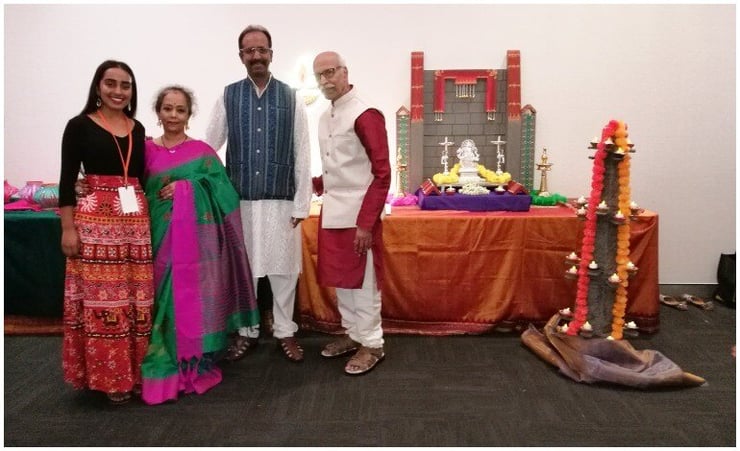Celebration of Lanterns and Lights: The exhibition at Wellington Diwali Festival

An exhibition Celebration of Lanterns and Lights displaying traditional diyas, lanterns, and lights attracted much attention at the Wellington Diwali Festival on Sunday, October 28.
The curator of the exhibition, Wellington-based Jyoti Gosavi, worked together with her husband, daughter, and father-in-law, to produce a magnificent display of traditional form of craft from the Indian state of Maharashtra.
The Indian Weekender spoke with Mrs Gosavi to learn more about her motivation and inspiration behind this exhibition.

IWK: Please tell us about your inspiration behind organising this Exhibition Celebration of Lanterns and Lights?
Mrs Gosavi: Diwali always brings to my mind numerous beautiful memories of togetherness, love and celebration. To emphasize how togetherness underpins this festival, this year I decided to do an exhibition titled –Celebration of Lanterns and Lights.
IWK: What is the first thing that came to your mind when you began conceiving about this exhibition?
Mrs Gosavi: My exhibition always carries two components – presentations of art and learning. In Wellington Diwali festival we presented different styles of traditional Indian lanterns, diyas, lights decoration, temple and home decoration followed with workshops on Lantern making.
IWK: Please tell us what exactly this exhibition showcases?
Mrs Gosavi: Lanterns are popularly called as ‘Kandil’ in Maharashtra and are made up of paper, plastic, cardboard etc. All paper-based lanterns were handmade at home by us using special lantern paper delivered from Mumbai. The process is laborious and requires precision with measurements and cutting. We had started our preparations about three months ago.
One of the highlights was a big ‘Aakashkandil ‘ made by me and my father in law using old-style technique. The hexagonal looking cage or structure of kandil was made with chopped tomatoes sticks tied together and glued with wheat flour paste.
The decorative papers were individually measured along with the numerous small pieces called ‘karanji’. It took over 12 hours to get this marvellous piece of work done and indeed was the centre of attraction.
The temple decoration backdrop was hand painted on tyrofoam and polystyrene packing material using acrylics.
Traditionally in India temples have a fixed concreted light stand called ‘Deepmala’ which has slots to put oil lamps in it. We created a stunning Deepmala using a garden stand (cone shaped) as our base structure and lined it up with wooden planks of different lengths at different heights. It was wrapped and tied nicely in thick cloth and overlaid with Plaster of Paris for firmness. After drying it was painted, and the diyas were placed on it. The credit for this innovative idea goes to my husband-Nilesh Gosavi and indeed attracted much attention at the festival.
The house decoration showcased an intricately made Indian family home, which was made out of ice cream sticks of various sizes, and shapes and this excellent piece was crafted by Priyanka Patil
The diyas were creatively hand painted by Mrudula Velhal and found it’s special place on Deepmala.
IWK: We noted there was a section dedicated to rangolis in the exhibition. Please tell us more about it?
Mrs Gosavi: Rangoli is an age-old traditional art that has been known to be passed on from mother to daughter or father to son. Under my guidance, my daughter Janhavi Gosavi took the lead in the completion of rangoli showing a combination of traditional Sanskar Bharati and dotted geometrical style rangoli.
IWK: How was the response to the lantern making workshop?
Mrs Gosavi: We got a tremendous response to the lantern making workshop conducted by senior artist Sugandha Bhonsule and young artist Janhavi Gosavi. They both taught different styles of Lanterns-making – an art they inherited from their father and grandfather. It was attended by over 70 kids and parents in a short span of 2 hours.
IWK: Your entire family was deeply involved in various aspects of the exhibition. Were they just helping you out for this endeavour or they also share a similar love for traditional art and crafts?
Mrs Gosavi: We as a family believe that art is life and life is art. We work together not only in life but also in our individual pursuit of satisfaction through art.
This exhibition was delightful, vibrant and interactive in many ways only because of the efforts and positivity put together by all artist, family and friends from various communities who helped right from providing material up to setting it up and packing it back.






Leave a Comment